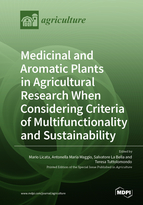Medicinal and Aromatic Plants in Agricultural Research When Considering Criteria of Multifunctionality and Sustainability
A special issue of Agriculture (ISSN 2077-0472). This special issue belongs to the section "Crop Production".
Deadline for manuscript submissions: closed (10 December 2021) | Viewed by 57572
Special Issue Editors
Interests: agronomy and crop sciences; constructed wetlands; wastewater reuse in agriculture; phytoremediation of polluted water and soil; industrial crops for energy use; aromatic and medicinal plants; turfgrass for sport fields; green roof ecosystem functioning
Special Issues, Collections and Topics in MDPI journals
Interests: natural compounds; organic chemistry; secondary metabolites from Mediterranean plants; volatile component
Interests: agronomy and crop sciences; aromatic and medicinal plants; constructed wetlands; wastewater reuse in agriculture; turfgrass; green roofs; industrial crops
Interests: agronomy and crop sciences; aromatic and medicinal plants; constructed wetlands; wastewater reuse in agriculture; turfgrass; green roofs; industrial crops
Special Issue Information
Dear Colleagues,
Over the last twenty years, agriculture has witnessed significant changes in terms of energy requirements, advanced technologies, and practices. This is in response to the impacts of crop production on the climate and environment and increasing awareness of the importance of agricultural sustainability through organic farming. Agriculture encompasses complex production systems, and certain aspects of multifunctionality and sustainability have become fundamental for these systems. Agricultural activity can provide various functions in agro-ecosystems, such as producing food, managing natural resources, and conserving landscape and plant biodiversity, contributing to the cultural, historical and economic viability of rural areas. Agriculture must now adopt scientific innovations in order to produce food which takes into consideration not only human wellbeing and the environment but also the requirements of farmers. Aromatic and medicinal plants (MAPs), as open field crops, can play an important role in multifunctional and sustainable agriculture, due to low energy requirements for cultivation and their many uses, from the production of nutraceuticals, phytonutrients, and phytotherapy to land valorization. Various MAPs are used in the food sector to flavor foods or prolong shelf-life, while others are used in modern and traditional medicine in the production of phytocomplexes for human health and well-being. The cultivation of MAPs, when based on an integrated and sustainable approach, can contribute to the conservation and increase of biodiversity in agro-ecosystems, as well as to the recovery of degraded and marginal lands. This Special Issue of Agriculture on “Medicinal and Aromatic Plants in Agricultural Research when Considering Multifunctionality and Sustainability Criteria” aims to illustrate the role of MAPs in agriculture under low-impact farming practices and the benefits they can generate in terms of functional products. This Special Issue accepts contributions that cover all research aspects related to MAPs, and a number of scientific macro-areas can also be included, such as agronomy, chemistry and pharmacy, ethnobotany and ethnopharmacology, food and nutrition, and ecology.
Original research and review papers are welcome. Papers chosen for publication will be selected by a rigorous peer-review procedure with the aim of rapid dissemination of the research results.
Key topics in this Special Issue include but are not limited to the following:
- Sustainable agricultural practices of MAPs;
- Breeding and germplasm preservation of MAPs;
- Biodiversity of MAPs;
- Conservation of cultivated and wild MAPs;
- Ethnobotany and ethnopharmacology;
- Phytotherapy, phytochemistry, and phytopharmacology;
- Essential oils and secondary metabolites;
- Functional foods and MAPs;
- MAPs and degraded and marginal land recovery;
- Global marketing of MAPs;
- Legislation of MAPs.
Dr. Mario Licata
Dr. Antonella Maria Maggio
Prof. Salvatore La Bella
Prof. Teresa Tuttolomondo
Guest Editors
Manuscript Submission Information
Manuscripts should be submitted online at www.mdpi.com by registering and logging in to this website. Once you are registered, click here to go to the submission form. Manuscripts can be submitted until the deadline. All submissions that pass pre-check are peer-reviewed. Accepted papers will be published continuously in the journal (as soon as accepted) and will be listed together on the special issue website. Research articles, review articles as well as short communications are invited. For planned papers, a title and short abstract (about 100 words) can be sent to the Editorial Office for announcement on this website.
Submitted manuscripts should not have been published previously, nor be under consideration for publication elsewhere (except conference proceedings papers). All manuscripts are thoroughly refereed through a single-blind peer-review process. A guide for authors and other relevant information for submission of manuscripts is available on the Instructions for Authors page. Agriculture is an international peer-reviewed open access monthly journal published by MDPI.
Please visit the Instructions for Authors page before submitting a manuscript. The Article Processing Charge (APC) for publication in this open access journal is 2600 CHF (Swiss Francs). Submitted papers should be well formatted and use good English. Authors may use MDPI's English editing service prior to publication or during author revisions.
Keywords
- Agricultural techniques
- Biodiversity
- Conservation
- Essential oils
- Ethnobotany and ethopharmacology
- Functional foods
- Legislation and market
- Natural products
- Nutraceuticals
- Phytochemicals
- Phytotherapy









